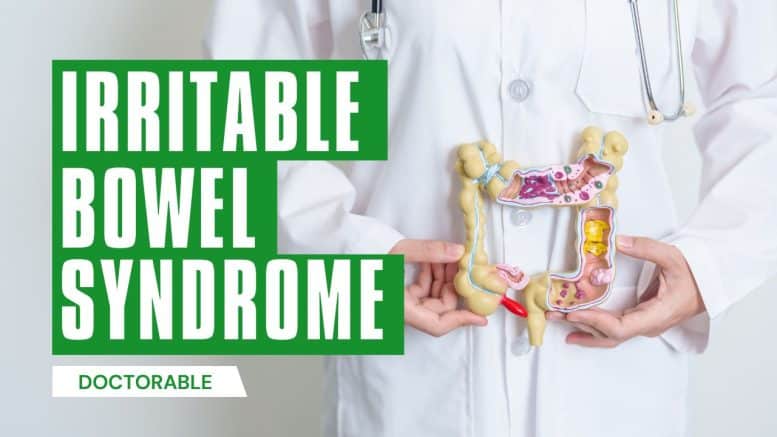Introduction To Irritable Bowel Syndrome
Irritable bowel syndrome (IBS) is a widespread gastrointestinal disease common in a large proportion of the population worldwide. It can range in manifestations, depending mainly on the patient’s lifestyle.
The main symptoms of IBS include abdominal pain, diarrhea, constipation, mucus discharge, hard or soft stools, and abnormal stools. Sometimes, patients may experience a combination of diarrhea and constipation.
Other common complaints of patients with IBS include bloating, distention, and changes in pain location and stool pattern with time (1). Concerning features of IBS include onset after the age of 50 years, severe symptoms, weight loss, nocturnal diarrhea, rectal bleeding, family history of organic gastrointestinal diseases, or iron deficiency anemia, which warrant further investigations.
The main subtypes of IBS include diarrhea dominant (IBS-D), constipation dominant (IBS-C), and a combination of both, known as IBS-M (mixed).
The origin of this prevailing disease is not directly apparent, as many factors can play a role in its etiology. Despite noteworthy research targeting the understanding of the pathophysiology of IBS, the exact mechanisms behind the development of symptoms are still not fully understood.
Definition
Irritable bowel syndrome (IBS) is a chronic gastrointestinal disorder characterized by abdominal pain and altered bowel habits, which may be triggered by specific pathogens and has been linked to alterations in microbiota. (2)
Epidemiology
According to a study conducted in the US in 2005, the total prevalence of irritable bowel syndrome in 5009 screening interviews was 14.1%, with abdominal pain being the most common symptom. Many patients also reported alternating constipation and diarrhea. This study also showed that most IBS sufferers in the US are undiagnosed. (3)
Meanwhile, recent data shows that the prevalence of IBS in the United States is between 7% and 16%, and it is most common in women and young people. Traditionally, the diagnosis of IBS has been based on the identification of symptoms that correlate with different syndromes linked with disorders such as IBS diarrhea, functional diarrhea, abdominal pain, or bloating. (4)
While IBS may not have a significant impact on increasing mortality rates, it still influences the quality of life of the patient due to the costly treatments (5). This fact has also been established through investigation (6).
Pathophysiology Of Irritable Bowel Syndrome
IBS is widely recognized as a multifactorial disorder, with proposed mechanisms as follows: gastrointestinal dysmotility, inflammation, visceral hypersensitivity, and altered intestinal microbiota. (7) Additionally, diet and exposure to stress have been proposed as contributing factors. (8)
Due to stress being identified as implicated in the pathogenesis of IBS, major components of the human stress response system and the hypothalamic-pituitary-adrenal (HPA) axis have been the subject of various IBS studies. (9)
Genetic predisposition and environmental interactions, such as psychosocial stress triggers, have also been implicated in the multifactorial pathogenesis of IBS. (10)
The gut-brain axis (GBA) consists of bidirectional communication between the central and the enteric nervous system, linking the emotional and cognitive centers of the brain with different peripheral intestinal functions (11). Disturbances in the brain-gut axis include central and autonomic nervous system abnormalities and peripheral factors such as peptides and hormones, which were found to be related to IBS pathogenesis. (12)
Diagnosis Of Irritable Bowel Syndrome
The diagnosis of IBS has proven to be an extremely challenging task. Traditionally, it has been diagnosed via a process of exclusion of other clinically defined illnesses. No unique or specific pathology has been demonstrated.
However, the need for creating diagnostic protocols for IBS has been increasing due to the cost burden and numerous patient referrals to GI clinics. Valid criteria that could lead to a diagnosis without the need for costly testing have been looked into, including the Manning Criteria, which introduced a form of a questionnaire. Through this, it was found that a thorough history can help reduce the use of expensive costing and increase diagnostic confidence.
In 1980, the Rome I criteria were proposed by a team as a guideline for diagnosis and, upon testing, instantly proved to be more valuable than any previous attempts. (13)
The Rome II Criteria, which was a modified version of the Rome I Criteria, was proposed by the same team. In this method, the questions specifying constipation and diarrhea were removed (14). In 2006, the Rome III criteria were further defined by an expanded Rome working team to include the following modifications:
- Introduction of a frequency threshold relating to symptoms (recurrent abdominal pain or discomfort for at least three days per month in the previous three months)
- Duration of symptoms was reduced to six months from twelve.
- The necessity to refine IBS sub-typing is considered sufficient for diagnostic purposes. (15)
For more information on the Rome IV criteria, including a chart on Bristol Stool Form score, please visit =https://theromefoundation.org/:
Differential Diagnosis
The differential diagnosis of IBS usually depends on whether the patient exhibits IBS with diarrhea or constipation. If the patient has IBS with diarrhea, the differentials include:
- Lactose intolerance
- Caffeine intake
- Alcohol intake
- Gastrointestinal infections, such as Amoeba, HIV, etc., inflammatory bowel disease, medication-induced diarrhea, celiac disease, malignancies, colorectal cancer, hyperthyroidism, VIPoma, and ischemic colitis. (16)
However, if constipation is the predominant symptom, then the differentials can include:
- Inadequate fiber intake
- Functional constipation
- Immobility
- Parkinson’s disease
- Spinal disease
- Diabetes
- Hypothyroidism
- Hypercalcemia
- Bowel obstruction
- Endometriosis
- Diverticular disease
Clinical Presentation
The various symptoms of IBS include GI and extra intestinal complaints, with the main GI symptom portraying chronic abdominal pain and altered bowel habits.
Chronic Abdominal Pain:
It is described as a sensation of cramps of varying intensity, usually located in the lower abdomen.
Altered Bowel Habits:
It is defined as any change in a patient’s stool, whether it be volume, frequency, or consistency.
Diarrhea:
Frequent loose stools of small to moderate volume generally occur when the patient is awake. Most bowel movements are preceded by lower abdominal cramps, urgency to defecate, and often fecal incontinence, as well as a feeling of incomplete defecation.
Large volume diarrhea, bloody stools, nocturnal diarrhea, and greasy stools, however, suggest organic disease and are not associated with IBS.
Constipation:
Characterized by hard and dry stools. Bowel movement becomes painful, and stools are difficult to pass.
Treatment Of Irritable Bowel Syndrome
Several options for relieving abdominal pain in IBS patients include antispasmodics, peppermint oil, selective serotonin reuptake inhibitors (SSRIs), and tricyclic antidepressants.
IBS-D Treatment
Interventions for bowel disturbances (IBS-D) include opioid agonists, antibiotics, bile salt sequestrants, probiotics, and 5-HT3 antagonists.
IBS-C Treatment
Constipation dominant (IBS-C) can be treated with chloride channel activators, polyethylene glycol (PEG), psyllium, and guanylate cyclase C agonists. (17)
Pharmacological Treatment
The American Gastroenterological Association (AGA) released several guidelines on the pharmacological management of IBS, with interventions based on patient subgroups of IBS-C and IBS-D. (18)
These guidelines vary in level of recommendation from conditional or weak to strong and are based on the quality of evidence (very low, low, moderate, and high). These guidelines also include recommendations for nine pharmaceutical agents in the treatment of IBS:
- Linaclotide
- Lubiprostone
- PEG laxatives
- Rifaximin
- Alosetron
- Loperamide
- Tricyclic antidepressants
- SSRIs and antispasmodics
The only strong recommendation, with high-quality evidence, is linaclotide, a guanylate cyclase C agonist, for patients with IBS-C.
Diet-based Treatment:
Clinical research has also been focusing on the improvement of IBS symptomatology through modifications in a patient’s diet. (19)
Ingestion of foods may contribute to the generation of chemoreceptors, mechanoreceptors, altered secretion, activation of motor reflexes, and colonic fermentation. (20)
Patients with IBS are much more likely than the general population to report adverse reactions to certain foods.
Dietary intolerance of IBS patients has been attributed to gluten, wheat, lactose, fermentable oligosaccharides, disaccharides, monosaccharides, and polyols (or FODMAPs), as well as fructose malabsorption. (21)
Conclusions
Awareness about the symptoms of IBS should be spread among the general public, so that they may take the appropriate step of consulting a medical professional in case of the occurrence of such a symptom.
Screening patients with complaints relating to abdominal cramps and related issues for IBS should be a common practice in all healthcare facilities. In this way, the medical field may advance toward better management of this disease.
Disclosures
The author does not report any conflict of interest.
Disclaimer
This information is for educational purposes and is not intended to treat disease or supplant professional medical judgment. Physicians should follow local policy regarding the diagnosis and management of medical conditions.
See Also
Heart Failure With Preserved Ejection Fraction
Community-Acquired Pneumonia in Adults
References
- Chey WD, Kurlander J, Eswaran S. Irritable bowel syndrome: a clinical review. Jama. 2015 Mar 3;313(9):949-58.
- Jeffery IB, O’Toole PW, Öhman L, Claesson MJ, Deane J, Quigley EM, Simrén M. An irritable bowel syndrome subtype defined by species-specific alterations in fecal microbiota. Gut. 2012 Jul 1;61(7):997-1006.
- Hungin AP, Chang L, Locke GR, Dennis EH, Barghout V. Irritable bowel syndrome in the United States: prevalence, symptom patterns, and impact. Alimentary pharmacology & therapeutics. 2005 Jun;21(11):1365-75.
- Camilleri M. Diagnosis and treatment of irritable bowel syndrome: a review. Jama. 2021 Mar 2;325(9):865-77.
- Inadomi JM, Fennerty MB, Bjorkman D. The economic impact of irritable bowel syndrome. Alimentary pharmacology & therapeutics. 2003 Oct;18(7):671-82.
- Agarwal N, Spiegel BM. The effect of irritable bowel syndrome on health-related quality of life and health care expenditures. Gastroenterology Clinics. 2011 Mar 1;40(1):11-9.
- Lee YJ, Park KS. Irritable bowel syndrome: an emerging paradigm in pathophysiology. World Journal of Gastroenterology: WJG. 2014 Mar 3;20(10):2456.
- Heitkemper M, Jarrett M, Jun SE. Update on irritable bowel syndrome program of research. Journal of Korean Academy of Nursing. 2013 Oct 1;43(5):579-86.
- Fichna J, Storr MA. Brain-Gut Interactions in IBS. Front Pharmacol. 2012;3:127.
- Fukudo S, Kanazawa M. Gene, environment, and brain‐gut interactions in irritable bowel syndrome. Journal of Gastroenterology and Hepatology. 2011 Apr;26:110-5.
- Carabotti M, Scirocco A, Maselli MA, Severi C. The gut-brain axis: interactions between enteric microbiota, central and enteric nervous systems. Annals of Gastroenterology: quarterly publication of the Hellenic Society of Gastroenterology. 2015 Apr;28(2):203.
- Camilleri M. Physiological underpinnings of irritable bowel syndrome: neurohormonal mechanisms. The Journal of Physiology. 2014 Jul 15;592(14):2967-80.
- Drossman DA. The functional gastrointestinal disorders and the Rome II process. Gut. 1999 Sep 1;45(suppl 2):II1-5.
- Chang L. From Rome to Los Angeles–The Rome III criteria for the functional GI disorders. Gastroenterology. 2006;130:1480-91.
- Drossman DA, Thompson WG. The irritable bowel syndrome: review and a graduated multicomponent treatment approach. Ann Intern Med.
- Lucak S. Diagnosing irritable bowel syndrome: what’s too much, what’s enough? MedGenMed. 2004;6(1):17.
- Lacy BE, Patel NK. Rome criteria and a diagnostic approach to irritable bowel syndrome. Journal of clinical medicine. 2017 Oct 26;6(11):99.
- Weinberg DS, Smalley W, Heidelbaugh JJ, Sultan S. American Gastroenterological Association Institute Guideline on the pharmacological management of irritable bowel syndrome. Gastroenterology. 2014 Nov 1;147(5):1146-8.
- Chey WD. Food: the main course to wellness and illness in patients with irritable bowel syndrome. Official journal of the American College of Gastroenterology| ACG. 2016 Mar 1;111(3):366-71.
- Eswaran S, Tack J, Chey WD. Food: the forgotten factor in the irritable bowel syndrome. Gastroenterology Clinics. 2011 Mar 1;40(1):141-62.
- Mullin GE, Shepherd SJ, Chander Roland B, Ireton‐Jones C, Matarese LE. Irritable bowel syndrome: contemporary nutrition management strategies. Journal of parenteral and enteral nutrition. 2014 Sep;38(7):781-99.


Follow us